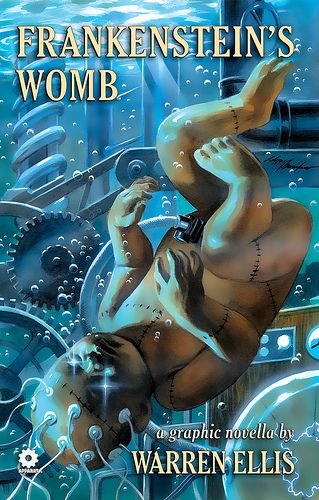Around the end of 1999, "Wizard" had an issue that featured an article where they argued who the next 'insert name' in comics is. I don't remember most of the pairings, but one that's always stayed with me was the section that proclaimed Warren Ellis is the next Alan Moore. It featured some glowing quotes on Ellis from Moore and some arguments based mostly on both men being British, having beards, and being confident in their abilities to the point of doing whatever projects suit their fancy. Beyond that, I've never really bought into the comparison since each writer's approach is different as their work shows.
Until now, that is. Warren Ellis' latest Apparat graphic novella from Avatar, "Frankenstein's Womb," is, by far, the most 'Alan Moore' book he has ever done, although it is framed by dialogue and sensibilities Ellis fans are accustomed to. Months before Mary Shelley began writing "Frankenstein," she, her future husband, and step-sister were traveling through Germany to Switzerland, and stopped at Castle Frankenstein, which, 100 years earlier, was home to Johann Conrad Dippel, an alchemist obsessed with finding an elixir for immortality. Here, Mary encounters a creature that inspires her famous novel.
That description doesn't quite do justice to Ellis' story, which is reminiscent of Moore's work where broad, seemingly disparate and unrelated, ideas are brought together to form one cohesive overarching whole. Where Moore used Jack the Ripper to discuss the birth of the 20th century, Ellis uses Mary Shelley to discuss concepts of life, death, and giving birth to the future. While not as specific as Moore, Ellis presents a compelling idea, returning to phrase "Corpses and lighting" again and again.
Drawing upon extensive research and only creating the fictitious encounter Mary has with Frankenstein's Monster, Ellis' writing here is both a history lesson, highlighting the role Mary Shelley and those acquainted with her had in the shaping of the 19th and 20th centuries, but also grounding the journey in real emotions. A scene where Mary is shown her mother giving birth to her, ten days before her mother died, is heartbreaking as she sees her mom for the first time and reacts in a way no one would expect.
The breadth of material covered here is extensive and delivered in a manner often found in Moore's work. However, Ellis's insight and directness is evident throughout. While informative, neither Mary or the Monster go on at great lengths, speaking only what's necessary, not often inclined to speak in purple prose. As well, his scenes with Percy Shelley are dripping with cynicism and dark humor -- especially at the end when we, and Mary, are made aware of what is to come for all three passengers in the carriage.
As with the other Apparat books, Ellis has partnered himself with the perfect artist for the particular project. Marek Oleksicki's art is gorgeous in black and white, his inks lush and moody. This is a book of darkness and shadows, and Oleksicki is perfectly at home here. The visual juxtaposition between Mary and the Monster is played up when appropriate, and his interpretation of the Monster is unsettling in its humanity - and lack thereof. For what is two characters taking a trip through time and events, Oleksicki keeps the book visually interesting when it could easily be a bore.
"Frankenstein's Womb" is not what many would expect from Warren Ellis at this point, but, like his other Apparat graphic novellas, he indulges in areas he's not normally known for, and once again proves that he's one of the most versatile writers in comics. And, for at least one moment, proves "Wizard" correct in calling him the 'next Alan Moore.'

